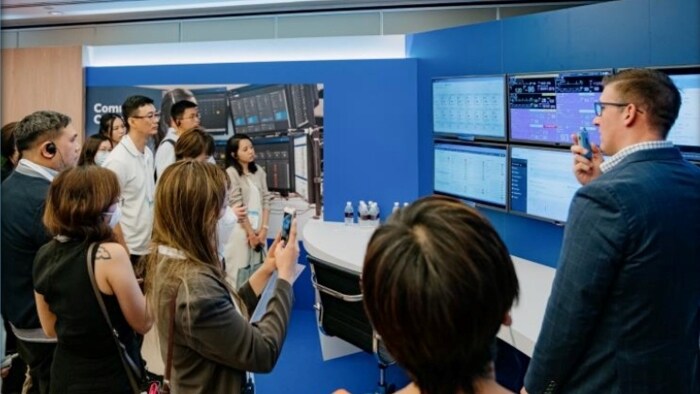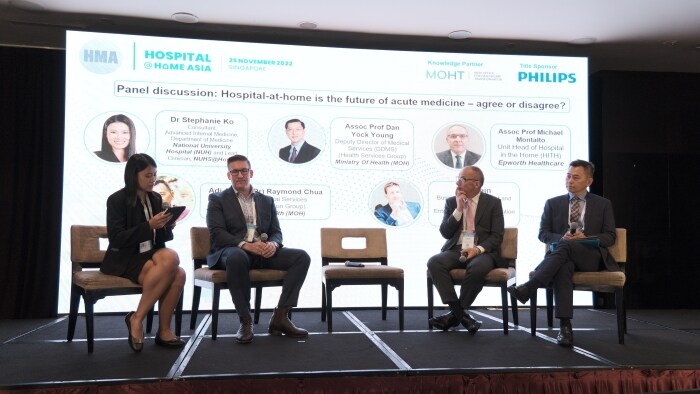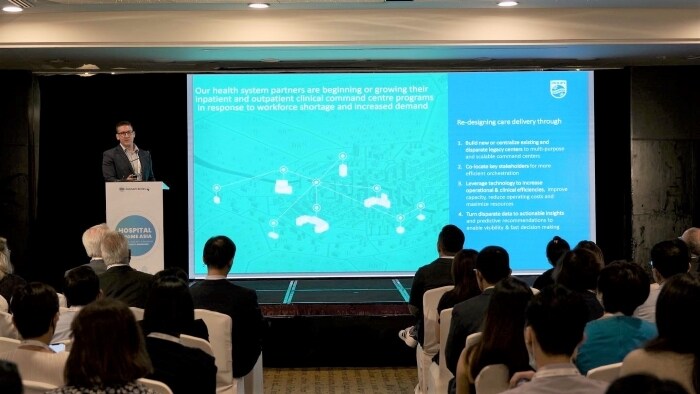Clinical command centres can promote scale of Hospital at Home programmes, through orchestrated connection of clinicians, patients, data and technology.

Interest and implementation of Hospital at Home (HaH) programs (defined as delivery of hospital-level care in patient homes) has expanded considerably over the past few years, particularly at the peak of the pandemic when many hospitals grappled with an unprecedented shortage of inpatient beds.
As a fairly new care model to Asia, much work still remains in optimising such services in terms of efficiency, effectiveness and patient experience.
The evolution of HaH, particularly across Singapore and Asia, were top of mind at HMA’s recent Hospital at Home Asia 2022 conference. Organised in partnership with Singapore’s MOH Office for Healthcare Transformation (MOHT), this event brought together healthcare leaders from Singapore, Australia and the US. Over the course of the conference, delegates shared success factors from their respective HaH programmes as well as the care coordination technologies that can be adopted to optimise these models for scale.

The role of clinical command centres
In his keynote speech, Mr Joe Cain, Business Development and Partnership Leader, Enterprise Care Collaboration, Philips APAC, highlighted the role of the clinical command centre in this redesign of care delivery.
Clinical command centres support efficient orchestration between field-based and hospital-based HaH stakeholders. Through these teams working in concert, we’re able to achieve operational and clinical efficiencies while maintaining quality patient care in the home. By leveraging hub-and-spoke care models with predictive technology, we can ultimately drive capacity creation, reduced inpatient bed days and better patient outcomes.”
Mr Joe Cain
Business Development and Partnership Leader, Enterprise Care Collaboration, Philips APAC
Particularly for HaH programs, clinical command centres present a holistic view of data from both inpatient and at-home perspectives, including remote monitoring of patient vital signs.
Such integration of data can help drive growth and confidence in HaH services from referring clinicians, he noted.
He raised the example of Grampians Health, a regional health system in Victoria, Australia. Grampians had seen a strong demand of admissions to its HaH programme over the past 5 years, with an average of 20 to 30 patients in the programme at any given time.
However, an analysis of length of stay data showed that there was a significant number “long-stay” patients, who consumed a high volume of bed days both in hospital and at home – with some patients requiring over 50+ days of HaH care.
This was where comparison of data sets uncovered a finding: that long-stay HaH admissions correlated with increasing complexity of DRG (diagnosis-related groups).
“Through this analysis we propose referring complex, yet stable, patients to the HaH program earlier to help to help boost hospital capacity while maintaining acute level care,” said Mr Cain.
Furthermore, benchmarking Grampians’ HaH service utilisation against that of other Australian hospitals revealed that for most DRGs, the proportion of HaH stays (as part of total hospital stays) at Grampians is below the national average.
Across Australia, HaH is performed on an average of 6% of multi-day separations, while the figure stands at less than 4% at Grampians.
This further suggests that it is reasonable to increase HaH admissions across most DRG profiles at Grampians, which will reap a substantial savings in bed days.
This growth can be achieved by leveraging on clinical command capabilities, Mr Cain pointed out.
“With clinical command centres, hospitals will have increased visibility of patients who are eligible for HaH at any given time, and therefore drive more referrals to the program. Clinicians can expect better integration of home monitoring devices in a way that closely replicates hospital-based monitoring and therefore more patient data to leverage in between consults. These data points will also help to prioritise virtual and face-to-face consults for clinical operations.”

The future of healthcare is more and more in the home
From discussions that took place at the HaH Asia conference, it was clear that the shift of healthcare from hospitals into the home is set to continue.
Hospitals, though, will continue to play a key role in the healthcare ecosystem - serving as a “central physical hub”, orchestrating the delivery of care across different care settings.
“In the future, HaH care will become a typical option for care delivery, for example as a natural referral mechanism for patients who are frequently admitted or who suffer from chronic diseases”, Mr Cain added.
Clinicians will be able to adjust the level of monitoring based on patient acuity, with those most severe equipped with integrated monitoring devices, and those less severe using mobile apps and patient-reported outcomes for clinician monitoring of their conditions.
All in all, the emergence of smart technologies has enabled the seamless connection of hospital to home. As such technologies continue to evolve and advance, we can look forward to further improvements in operational efficiencies, clinical outcomes, and last but not least, smoother experience for patients both within and beyond hospital walls.
Position paper: The smart hospital of the future is a hospital without walls
Learn more about our vision on the future of hospital care as part of a wider ecosystem of care that extends into the home and the community.
Mr Joe Cain, Business Development and Partnership Leader, Enterprise Care Collaboration, Philips APAC, was one of the keynote speakers at Hospital @ Home Asia 2022, where he spoke about “Philips Hospital in the Home: Promoting Scale while Measuring Meaningful Benefits”.











